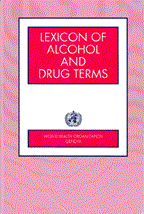Psychoactive substances
Psychoactive substances are substances that, when taken in or administered into one's system, affect mental processes, e.g. cognition or affect. This term and its equivalent, psychotropic drug, are the most neutral and descriptive term for the whole class of substances, licit and illicit, of interest to drug policy. ‘Psychoactive’ does not necessarily imply dependence-producing, and in common parlance, the term is often left unstated, as in ‘drug use’ or ‘substance abuse’.

Lexicon of alcohol and drug terms
ICD-10 classification of mental and behavioural disorders
The Tenth Revision of the International Statistical Classification of Diseases and Related Health Problems (ICD-10) includes in Chapter V a detailed classification of over 300 mental and behavioural disorders. Its publication follows extensive field-testing by more than 100 clinical and research centres in 40 countries.
There are two main versions available: Clinical Descriptions and Diagnostic Guidelines and Diagnostic Criteria for Research. The former provides clinical descriptions detailing the principal signs and symptoms of each disorder, together with other important but less specific associated features, as well as comprehensive guidelines for their diagnosis. The latter version is intended to help those researching specific disorders to maximize the homogeneity of study groups. To this end, it sets out criteria that allow the selection of individuals with clearly similar symptoms and other characteristics.
- ICD-10 Clinical descriptions & diagnostic guidelines
This document contains a listing of ICD-10 clinical descriptions and diagnostic guidelines for mental and behavioural disorders due to psychoactive substance use (F10 - F19). - ICD-10 Diagnostic criteria for research
This document contains a listing of ICD-10 diagnostic criteria for research for mental and behavioural disorders due to psychoactive substance use (F10 - F19). - Browse ICD-10 Version:2019
- Obtain more information on ICD-10
ICD-11 classification of mental and behavioural disorders
Changes in the classification of substance use disorders in the Eleventh Revision of the International Classification of Diseases and Related Health Problems , based on a public health approach, have important implications for the conceptualization, structure and availability of services. These include: (1) an updated and expanded range of substance classes; (2) greater specification of different harmful patterns of substance use, which may be continuous or episodic and recurrent; (3) a new category to denote single episodes of harmful use; (4) a category describing hazardous use of substances; and (5) simplification of diagnostic guidelines for substance dependence.
Diagnostic categories and terms in ICD 11
Disorders due to substance use
Disorders due to addictive behaviours
